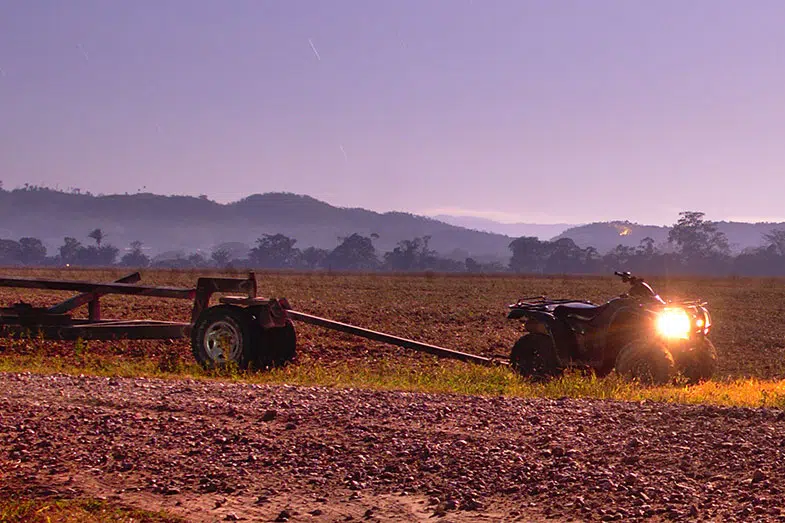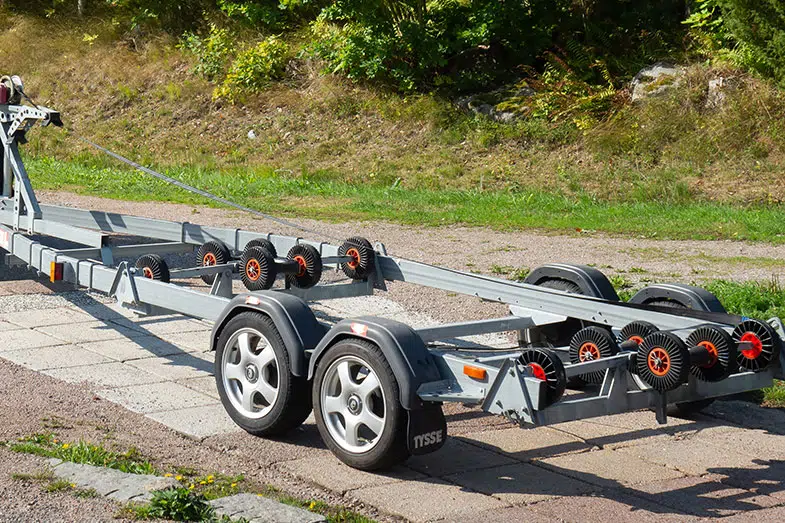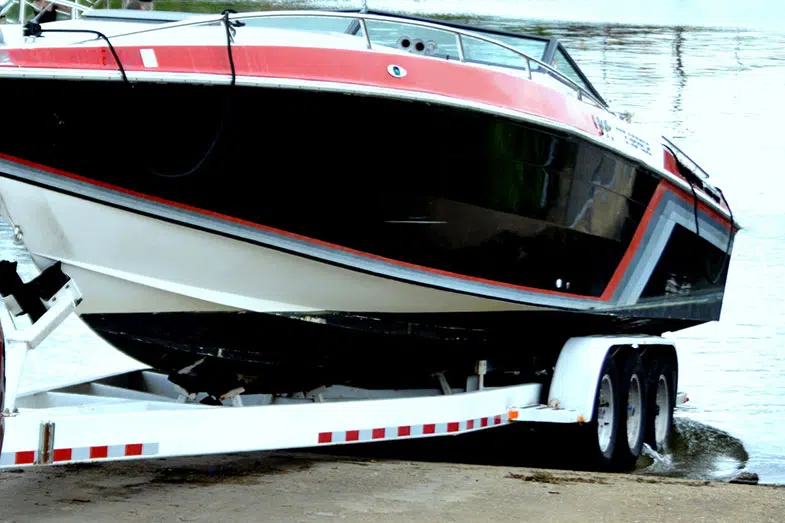If you’re looking for simple ways to tow a boat, the first thing you need to think about is the right vehicle to pull it. Since an all-terrain vehicle (ATV) is easier to control than cars, trucks, vans, and SUVs, we can’t blame you if you think pulling a boat is easier with it.
Can an ATV pull a boat out of the water? A 600-pound 4×4 ATV can tow a 3,000-pound pontoon or deck boat out of the water, but it may damage the ATV or pull it down. After all, you still need to use a ramp. On flat surfaces, there’s a higher chance for the whole endeavor to work.
Based on the average towing capacity of ATVs and the average weight of boats, it’s not advisable. It may be possible with vehicle modifications, but that may only take a toll on your ATV.

Still confident about the capabilities of your ATV? Well, it’s better to understand the specifics and to learn more about the realities of using an ATV to tow a boat.
ATVs and Boat Towing
We have to admit; some people manage to tow their boats out of the water with their ATVs. Unfortunately, that only happens in some cases.
Despite their limitations, ATVs are still commonly used in boatyards. That’s because most people there are using the biggest type of ATVs from the best brands. Also, a lot of them use sandy ramps that aren’t too steep. Some even customize their ATVs with additional weights to make them heavier.
Why You Should Not Use an ATV to Pull a Boat out of Water
As for the reasons why using an ATV to tow a boat is a bad idea, we’re sharing a list of factors from expert opinions and actual experiences.
- The brake power isn’t strong enough.
- Too much power can burn the machine’s drive belt.
- The ramp is slippery since it’s exposed to water.
- Trucks, which are heavier than ATVs, can still be pulled back by boats.
- ATVs are significantly lighter than boats.
How Much Weight Can an ATV Pull?
So, what exactly can an ATV tow? Anything that weighs no more than 1,500 pounds (680 kilograms) will do. To be exact, ATVs can pull things as heavy as 1,200 pounds (544 kilograms) up to 1,500. However, the ATV should be heavier than the standard for the sake of traction and resistance from the trailer.
Also, the capacity of any ATV can only be utilized on a flat surface. It will never work on steep slopes exceeding 15 degrees.
Lastly, as much as possible, make sure to tow your boat in cool weather. Overheating mostly happens on sunny days. But, if you’re going to drive your ATV slowly and in low gear, there’s a lower chance of overheating.
What if you’ll force your ATV to pull boats heavier than its towing capacity? The trailer may bump into the ATV when moving down a slope and push it off its path unless you quit stepping on the brakes too hard and let the vehicle move faster a little bit.
What Are ATVs Used For?

Since ATVs aren’t exactly great for towing boats, most people use them for these uses instead:
- Plowing snow and fields
- Mowing or raking lawns
- Spreading seeds or rocks for landscaping
- Carrying logs, sand, concrete, and other materials used for construction
- Camping
- Simple rescues (e.g., pulling people, animals, or other ATVs from deep mud)
Can an ATV Pull an 18-Foot Boat out of the Water?
Despite the towing limitations of ATVs, some people are still hoping that one can pull an 18-foot boat. Unfortunately for them, it’s not about the boat’s length – it’s always about weight.
Still not convinced? Here are the different types of boats with their corresponding average weight plus the vehicles that can tow them without any hassle.
- Sailboat (8,800 lbs) = trucks
- Cabin cruiser (8,700 lbs) = trucks
- Speed boat (8,000 lbs) = trucks
- Ski boat (3,500 lbs) = SUVs, trucks
- Pontoon/deck boat (3,100 lbs) = SUVs, trucks
- Traditional fishing boat (1,700 lbs) = Crossovers, SUVs, trucks
- Personal watercraft (PWC) (850 lbs) = cars, SUVs, vans, trucks
Since ATVs can tow a maximum weight of 1,500 pounds, it’s clear that they’re great for pulling PWCs or water scooters. A PWC is usually referred to as a Jet Ski due to the brand being a household name.
PWCs are still considered boats since the rider usually sits on it, just like when we ride speed boats and ski boats. The U.S. Coast Guard even calls PWCs jet-drive boats.
How Do You Tow a Boat?

Towing a boat means to transport it towards your destination by pulling it with a large, powerful motor vehicle. It shouldn’t be too complicated; you just have to remember some safety tips while driving. What’s more important is how you prepare for it, especially when you hitch the trailer.
Read on to learn the things you need to do, starting from the preparations for the boat launch.
How to Hitch a Trailer
- Move the trailer hitch (view on Amazon) lower until it’s on top of the ball.
- Use the safety pin to secure the closed latch.
- Cross the chains before connecting each end to the vehicle you’re going to use.
- Connect some sort of line to the vehicle for safety if the trailer comes with its own brakes.
- Prepare the lights by plugging them all in.
Next, check out the following safety tips to make sure all the preparations are set and your driving will match the additional weight you’re towing:
- Inspect everything from your vehicle to the trailer.
- Check if the tongue weight doesn’t exceed 15% of the cargo.
- Stop your vehicle in a safe, spacious area and adjust the cargo whenever the trailer sways.
- Your turns while driving should always be wide enough to prevent hitting obstructions.
- Widen the gap from the vehicle before you since the extra load can affect your brakes.
- If it’s a windy day, prevent your rig from going further sideways by neither braking nor accelerating.
- Focus on the side mirrors, not the rear.
Other than those safety tips, it’s best if you practice towing in an empty parking lot. Your usual drives are no match for the demands of towing a boat.
When you arrive at your destination, the next thing you should do is to back the trailer. That’s necessary before you can launch the boat.
How to Back a Trailer
- Drive forward as you position the trailer near the ramp until you align the trailer to your vehicle.
- Always glance at each side mirror – should be the extended or towing type (view on Amazon) as you slowly reverse.
- Correct your direction immediately once the boat moves to the right or left to maintain a straight path (drive a little bit to the right if the boat moves left and vice versa).
How to Prepare Before Launch
- Put every piece of essential gear on the boat.
- Take off any transom strap.
- Place one or more drain plugs according to what your boat needs.
- Recheck the drain plugs to make sure of the correct placement.
- Pull out the plug for the incandescent lights (if any) for safety purposes.
- Put the mooring lines on the cleats if needed.
How to Launch a Boat
- Drive backward until the stern floats on the water.
- Park your vehicle.
- Chock the wheel if you’re towing a big boat.
- Remove the boat’s chain and strap.
- Start the boat’s engine.
- Put the boat in reverse.
- Apply enough power to ease the boat off the trailer slowly.
- Drive your vehicle backward a little bit if the boat won’t move.
- Transfer the boat to a courtesy dock immediately if you’re using a public ramp.

See how tricky it is to launch a boat? That’s why using an ATV to tow should try to be avoided. Despite the immense strength of some ATVs, pulling a heavy boat may damage their brakes and drive belt. They’re also susceptible to accidents because of slippery ramps and uneven weight distribution.
Remember, ordinary ATVs have a towing capacity of only 1,500 pounds max. And that’s only based on flat ground.
The ramp’s slope will make the boat heavier for the ATV, so it’s best to stick with big vehicles when towing, backing, and launching boats. ATVs are best for PWCs only while trucks can tow boats up to 8,000 pounds.
References
- https://forums.iboats.com/forum/general-boating-outdoors-activities/trailers-and-towing/371618-will-a-4×4-atv-pull-an-18-boat-out-of-the-water
- https://boostatv.com/atv-weight/
- https://outdoortroop.com/average-boat-weights-with-25-examples-can-you-tow-it/
- https://www.boats.com/how-to/boat-towing-basics-learn-how-to-trailer-a-boat/
Kris is an avid off-roader and outdoor enthusiast who loves to brave the elements and take on challenging terrain. He also enjoys sharing his passion and knowledge with others so that they, too, can appreciate the ride.
About Kris
